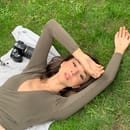“Art & love are the same thing: It’s the process of seeing yourself in things that are not you” – Clark Klosterman

“Art” can generally be defined as a a product with some sort of aesthetic property—something which makes people feel something. In my opinion, art is a vastly ambiguous concept, allowing for people to interpret it in various different ways.
The image below, for example, can be interpreted in contrasting ways, and it may create a lot of questions. Who are the two people here? Why do they have blue hair? Why are they both wearing yellow shirts? Why are they standing separated by the flower, and what does the flower symbolize?
The ambiguity of art allows us to express and nurture our own unique creative environment and imagination. If you pay close enough attention, art can actually be found all around us.
The concept of art is universal, and can be seen everywhere—if there was no art, we would not see beauty in the things around us.
Of course, there is beauty and emotion attached to the classics of art, such as literature, linguistics, theatre, paintings, music and so on. Each of these types of art have the ability to make people feel something, especially aesthetes—those who feel a deep sensitivity to art and the beauty of it.
But what about the less noticeable things around us?
Take a look at the image above: A bee pollinating. At first glance, it’s simply just a bee pollinating, but upon closer look, you can see the beauty—the art—within this moment.
The flower on its own is alluring; aesthetic to some, perhaps unsightly to another. It has small black buds which are allowing the bee to extract pollen from it; it’s flourished with gorgeous shades of pale baby blue, pastel purple, and green. Through an artistic point of view, perhaps flowers symbolize the fleeting nature of human existence—a quick, yet beautiful experience.
Then, examining the bee, you realize it is much more than a bug. It’s a creature with sharp shades of black and yellow, with exotic looking wings under the microscope, playing a fundamental purpose in pollinating (fertilizing) our plants. Without the bee, the availability and diversity of fresh produce would decline substantially, human nutrition would suffer, and the food chain would be endangered.
The grave importance of the bee brings me to the philosophical theory of the Butterfly Effect, which can be described as the sensitive dependence on initial conditions in which a small change may lead to nonlinear results. The Butterfly Effect in itself is art: Art significantly impacts people emotions, thoughts, opinions, ideals and experiences at different places and times.
It is through something as small as the bee and the flower which allows one to realize that perhaps art gives meaning to life, and helps us understand our world. Through increasing our self-awareness and developing a deeper understanding of our emotions, we grow a connection to the beauty—the art—of the world around us.
It then becomes feasible to say that life itself is an art.
Art gives us the ability to activate our communication skills and release dopamine, more commonly known as our “feel-good” hormone. It activates our senses and emotions, two things which we use in our everyday lives.
Art allows one to experience beauty, hardships, emotions, questions, decisions and perceptions. Through these actions and emotions in which the human brain functions and which we essentially perceive our world, humanity is easily expressed through art.
If artists are known as people who always ask questions to gain a deeper understanding of the world around them, pave their own ways in life, embrace their emotions, they reflect, and see the world through their own personal lens, then is human nature not art? Are we not all artists?
Life is an art and everyday we practice the art of living. From embracing emotions and experiences, to seeing the Earth’s soil, to watching live theatre productions, to feeling the simplicity of a hug, art is everywhere around us and the world is much more beautiful than we are aware of.







